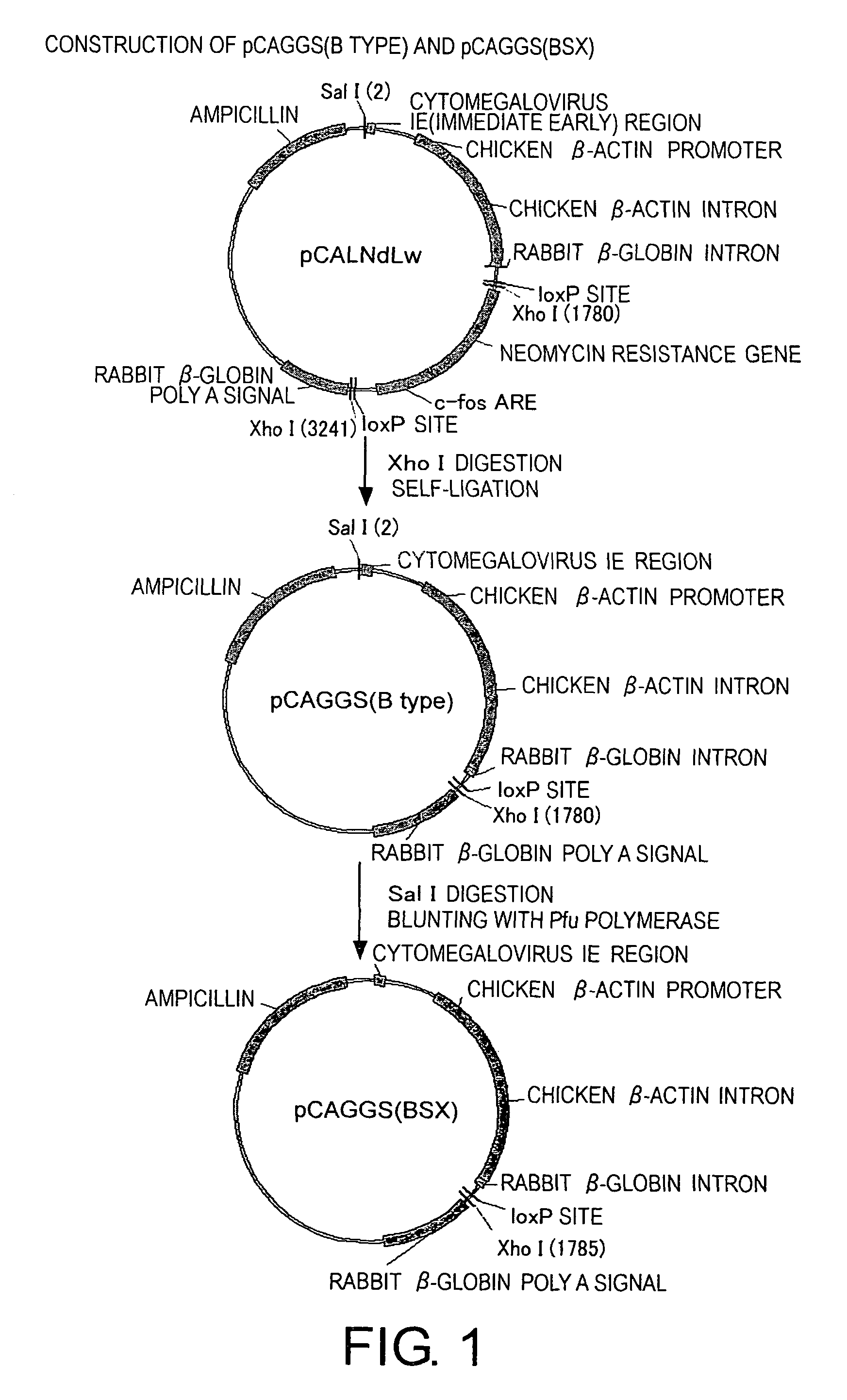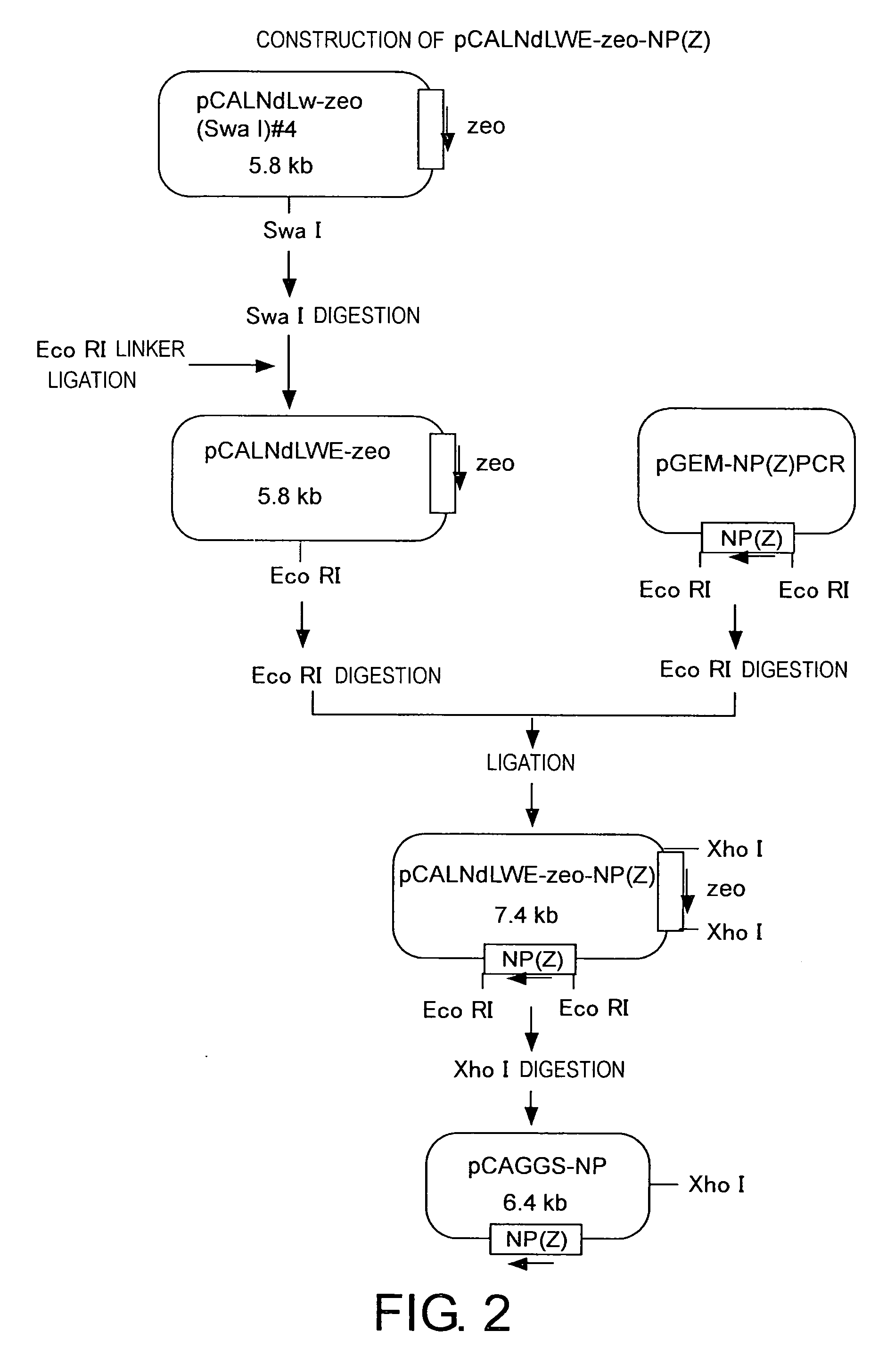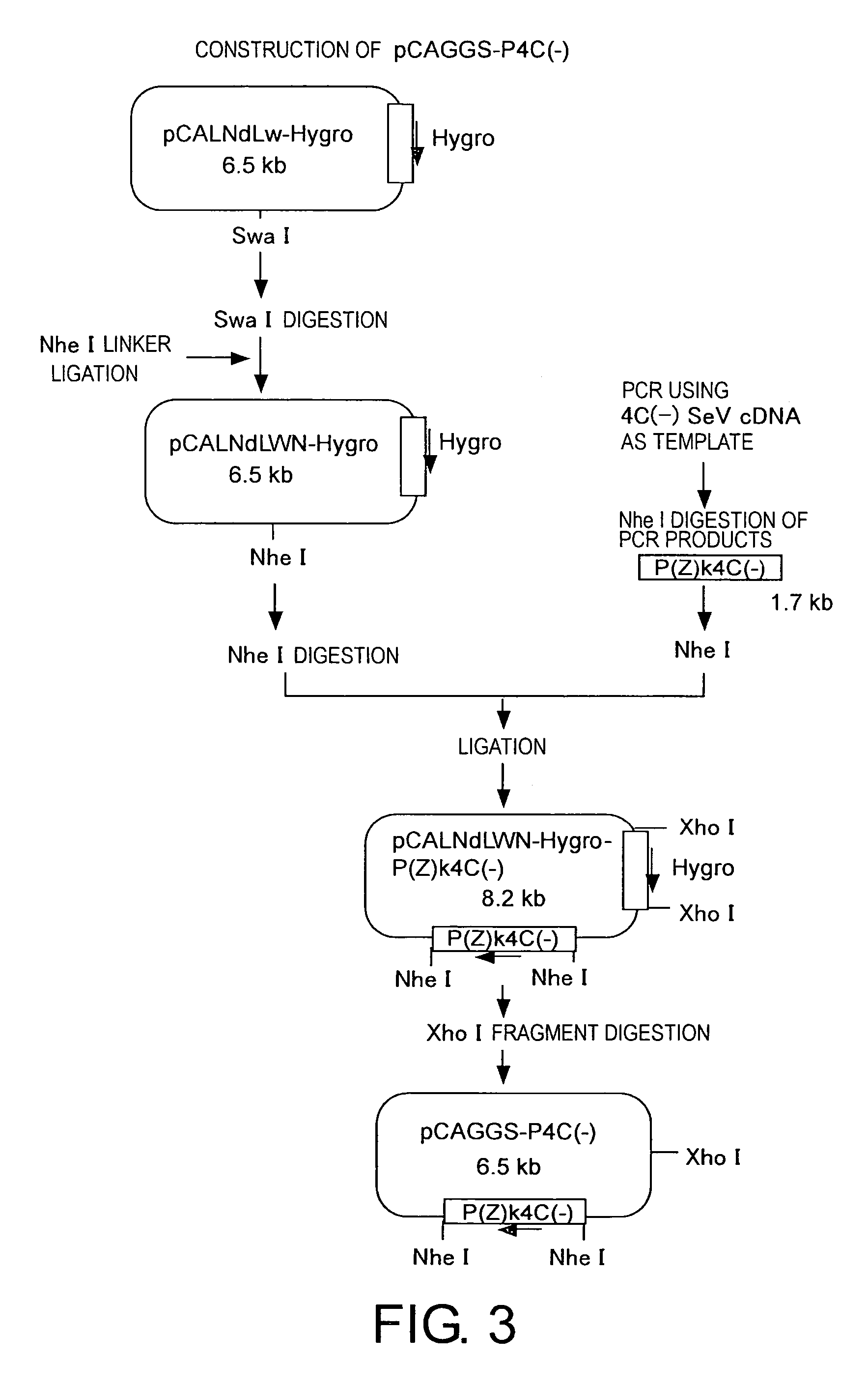Methods for producing minus-strand RNA viral vectors using hybrid promoter comprising cytomegalovirus enhancer and chicken β-actin promoter
a technology of minus-strand rna and promoter, which is applied in the direction of antibody medical ingredients, genetic material ingredients, recovery/purification, etc., can solve the problems of inability to recapture capsaicin and inability to reconstitute non-transmissible viruses in the past, and achieve high safety
- Summary
- Abstract
- Description
- Claims
- Application Information
AI Technical Summary
Benefits of technology
Problems solved by technology
Method used
Image
Examples
example 1
Plasmid Construction (FIG. 1)
Construction of pCAGGS (B type)
[0178]pCALNdLw (Arai, T. et al. J. Virology 72, 1998, p. 1115-1121) was digested with XhoI, purified using the Qiaquick PCR Purification kit, and ligated. The plasmid from which the XhoI fragment was deleted was selected and named pCAGGS (B type). pCAGGS (B type) was digested with SalI, and blunted using the Pfu DNA polymerase. The DNA was purified with the Qiaquick PCR Purification kit, and ligated. The plasmid in which the SalI site was deleted was selected and named pCAGGS(BSX)
Construction of pCAGGS-NP (FIG. 2)
[0179]pCALNdLw was digested with SpeI and EcoT22I, and separated by agarose gel electrophoresis. The 2651-bp and 3674-bp fragments were excised, and purified with the Qiaquick gel Extraction kit. Then, the 2651-bp fragment was digested with XhoI. After separation by agarose gel electrophoresis, a 1760-bp band was purified. The Zeocin resistance gene was amplified by PCR using pcDNA3.1 / Zeo(+) as template and the fol...
example 2
Establishment of T7 RNA Polymerase-expressing BHK-21 (Hereinafter Referred to as BHK / T7)
[0188]Using a mammalian transfection kit (Stratagene) or SuperFect (Qiagen), BHK-21 cells (ATCC CCL-10) were transfected with pCALNdLWE-T7 that was constructed as described above. The cells were cultured for 2 weeks in D-MEM containing 400 μg / ml G418 at 37° C. under 5% CO2, yielding drug-resistant clones grown from a single cell. The resulting drug-resistant clones were infected with recombinant adenovirus (AxCANCre) that expresses Cre DNA recombinase at an Moi of 4. After 24 hours, the cells were washed once with PBS and harvested. The expression of T7 RNA polymerase was confirmed by Western blotting analysis using a rabbit polyclonal anti-T7 RNA polymerase antibody.
[0189]Clones that were confirmed to express the T7 RNA polymerase were transfected with pGEM-IRES-Luci using SuperFect. The cells were harvested after 24 hours, and their luciferase activity was measured with MiniLumat LB9506 (EG&G B...
example 3
Production of a Recombinant Sendai Virus by a Conventional Method
[0190]LLC-MK2 cells were plated at 5×106 cells / dish in 100-mm Petri dishes. After 24 hours of culture, the cells were washed once with serum-free MEM and infected at room temperature for 1 hour (moi=2) with a T7 RNA polymerase-expressing recombinant vaccinia virus (Fuerst, T. R. et al., Proc. Natl. Acad. Sci. USA 83, 8122-8126 (1986)) after the recombinant vaccinia virus was treated with 5 minutes of 3 μg / ml psoralen and long wavelength ultraviolet light (365 nm). The cells were washed twice with serum-free MEM. 12 μg / dish of the cDNA of an F-deficient Sendai virus vector carrying Lac Z (pSeV (+18:LacZ)ΔF), 4 μg / dish of pGEM / NP, 2 μg / dish of pGEM / P, 4 μg / dish of pGEM / L (Kato, A. et al., Genes Cells 1, 569-579(1996)), and 4 μg / dish of envelope plasmid pGEM / FHN are mixed, and then suspended in Opti-MEM (GIBCO). The SuperFect transfection reagent (1 μg DNA / 5 μl of SuperFect; QIAGEN) was added and allowed to stand at room ...
PUM
| Property | Measurement | Unit |
|---|---|---|
| concentration | aaaaa | aaaaa |
| concentration | aaaaa | aaaaa |
| cap structure | aaaaa | aaaaa |
Abstract
Description
Claims
Application Information
 Login to View More
Login to View More - R&D
- Intellectual Property
- Life Sciences
- Materials
- Tech Scout
- Unparalleled Data Quality
- Higher Quality Content
- 60% Fewer Hallucinations
Browse by: Latest US Patents, China's latest patents, Technical Efficacy Thesaurus, Application Domain, Technology Topic, Popular Technical Reports.
© 2025 PatSnap. All rights reserved.Legal|Privacy policy|Modern Slavery Act Transparency Statement|Sitemap|About US| Contact US: help@patsnap.com



